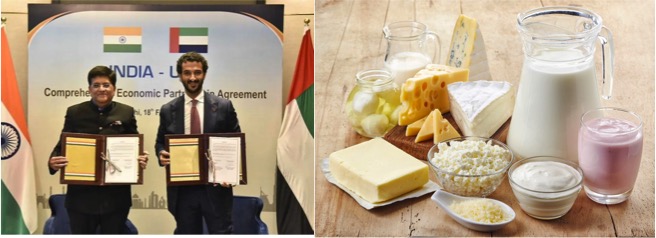India has kept sensitive dairy products out of the purview of its free trade agreement (FTA) with the UAE and pledged phased reduction of tariffs on certain key farm and food items, mainly meat, to safeguard the interests of domestic players.
The details of the India-UAE Comprehensive Economic Partnership Agreement (CEPA) show New Delhi, which taxes bovine meat and chicken imports at 30%, will trim the duty to 27% in the first year of the FTA, followed by a phased reduction of 300 basis points each year until it reaches 15%.
Buffalo meat alone contributed about $2.8 billion to India’s farm export kitty until January this fiscal. Of course, in some other meat segments where it’s not a big player, the duties will be abolished immediately.
A broad range of dairy products, including milk, yogurt, butter, ghee and cheese, which typically attract duties of 30-60%, are excluded from the ambit of the agreement. The fact that New Delhi didn’t grant concession to the UAE, which isn’t a large dairy player (unlike Australia), suggests the sensitivity it attaches to the dairy sector that was at the forefront of opposing a deal with the Beijing-dominated RCEP partners.
The details were unveiled by commerce and industry minister Piyush Goyal in Dubai on Sunday. New Delhi signed the CEPA — its first FTA with any economy in a decade — with the UAE in February and it will come into force on May 1.
Interestingly, India will scrap a 20% duty for the UAE on gold jewellery, subject to a quantitative cap of 2.5 tonne annually in five years. This could help several Indian companies like Kalyan Jewellers and Malabar Gold & Diamonds that have operations in the UAE to supply from there.
Both the sides have also agreed to a separate document on pharmaceuticals to facilitate greater access of Indian products, including automatic registration and marketing authorisation, in 90 days for several items that meet specified criteria.
According to the pact, the UAE will allow as many as 99% of Indian goods (in value terms) at zero duty in five years from about 90% in the first year.
Similarly, India would allow duty-free access to 80% of goods from the UAE now and it would go up to 90% in ten years.
The UAE is India’s second-largest merchandise export destination and bilateral trade (both goods and services) hit $60 billion in the pre-pandemic year of FY20. Through the CEPA, both the sides are aiming to raise bilateral trade (both goods and services) to $100 billion in five years.
New Delhi has also kept certain sensitive sectors and products, including most of those covered under the production-linked incentive schemes, out of the FTA’s purview. These products include fruit, vegetable, cereals, tea, coffee, sugar, food preparation, tobacco, petroleum waxes, coke, dyes, soaps, natural rubber, tyres, footwear, processed marbles, toys, plastics, scrap of aluminium and copper, medical devices, TV pictures, auto and auto components.
Indian jewellery exporters will get duty-free access to the UAE, which currently slaps a 5% customs duty on such products. This will substantially raise its jewellery exports.
As for services trade, New Delhi has offered market access to Abu Dhabi in about 100 sub-sectors, while Indian service providers will have access to 111 sub-sectors there encompassing 11 broad service sectors. These are business services, communication services, construction and related engineering services, distribution services, educational services, environmental services, financial services, health related and social services, tourism and travel related services, recreational cultural and sporting services and transport services.
The UAE, however, has kept energy and energy-related services out of the purview of its commitments.
Interestingly, for the first time, India has included a digital trade chapter in the FTA, unlike those that were signed in the past. This suggests India is willing to discuss prospects in such emerging areas bilaterally.



























